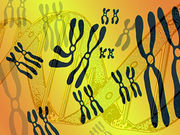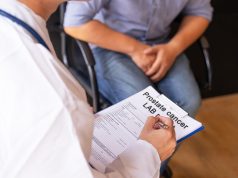Time to metastasis, length of survival vary by number of HSD3B1 (1245C) variant alleles
THURSDAY, Oct. 12, 2017 (HealthDay News) — The HSD3B1 (1245C) allele is associated with more rapid development of metastases in men with biochemically recurrent prostate cancer, and it predicts response to nonsteroidal CYP17A1 inhibition, according to two studies published online Oct. 12 in JAMA Oncology.
Jason W.D. Hearn, M.D., from the University of Michigan in Ann Arbor, and colleagues retrospectively determined the HSD3B1 genotype in 213 men treated with androgen-deprivation therapy for biochemically recurrent prostate cancer after primary radiotherapy between 1996 and 2013. The researchers found that the HSD3B1 (1245C) allele was associated with more rapid development of metastases. Overall variant allele frequency was 32 percent. Median time to metastasis fell with the number of variant alleles inherited: 7.4 years (95 percent confidence interval, 6.7 to 9.7) with no inherited variant alleles, 5.8 years (95 percent confidence interval, 4.9 to 6.5) with one variant allele, and 4.4 years (95 percent confidence interval, 3 to 5.7) with two variant alleles (P = 0.03).
In a separate study, Nima Almassi, M.D., from the Cleveland Clinic in Ohio, and colleagues assessed whether the HSD3B1 (1245C) genotype is predictive of clinical response to extragonadal androgen ablation with nonsteroidal 17α-hydroxylase/17,20-lyase (CYP17A1) inhibition in 90 men with metastatic castration-resistant prostate cancer (CRPC). They found that median progression-free survival increased with number of HSD3B1 (1245C) variant alleles inherited: 5.4 months (95 percent confidence interval, 3.7 to 7.5) for zero variant alleles; 9.7 months (95 percent confidence interval, 5.6 to 32.9) for one allele; and 15.2 months (95 percent confidence interval, 7.8 to not reached) for two (overall comparison for trend, P = 0.03.
“These findings signal a possible pathway of treatment stratification for patients with prostate cancer,” Almassi and colleagues write.
One author in both studies is listed as a co-inventor on a patent application for a method of disease treatment based on HSD3B1.
Abstract/Full Text (subscription or payment may be required) — Hearn
Abstract/Full Text (subscription or payment may be required) — Almassi
Editorial (subscription or payment may be required)
Copyright © 2017 HealthDay. All rights reserved.








